Managing farmscapes for biodiversity conservation and ecosystem services
By Alejandra Martínez-Salinas, Fabrice DeClerck, Kelly Garbach, Natalia Estrada-Carmona
This blog is part of the Agriculture and Ecosystems Blog’s month-long series on Ecosystem Services.
It is safe to state that human life on earth depends on the conservation of biodiversity. We can even picture ecosystems as the heart and veins of our natural world, sustaining and connecting biodiversity, and providing functions and services. In spite of this general consensus, we know very little about how these connections work, how strong or vulnerable they are, and how easy or difficult they are to destroy or rebuilt once lost.
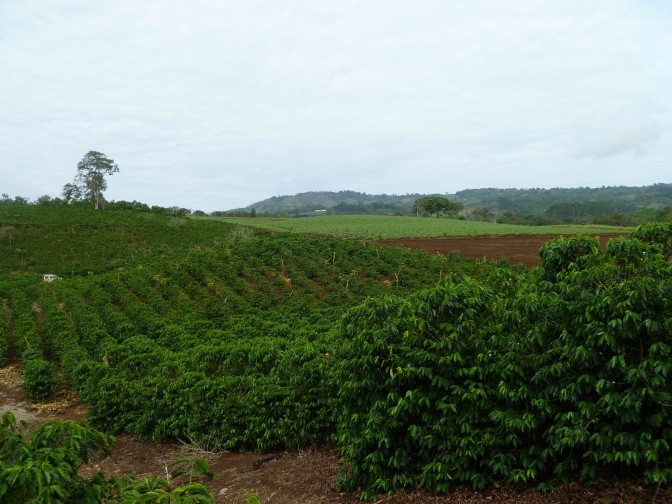 Coffee fields and sugar can plotes on CATIE Farm. Photo Credit: Alejandra Martínez-Salinas
Coffee fields and sugar can plotes on CATIE Farm. Photo Credit: Alejandra Martínez-Salinas
One of the CGIAR Research Program on Water, Land and Ecosystem’s interest has been to better understand how agricultural ecosystems contribute to conserving Costa Rica’s birds; and whether these birds ‘return the favor’ by providing ecosystem services. We are looking specifically at the relationship between birds and the control of pests in coffee fields.
In central Costa Rica over the past six years, we have been capturing birds in seven areas with different agricultural land uses on the 1000 ha CATIE[1] research station to understand how farm management impacts habitat quality and bird mobility; both elements are needed for a species to survive and adapt.
In a second study, we have been measuring how many coffee boring beetles these birds consume to understand which groups of birds provide the best pest control function. We as ecologists are moving from measures of species diversity and richness – toward measures of functional diversity that focus on the role that different groups of species play in providing ecosystems services. A better understanding of the functions that biodiversity plays will help guide farm management practices that are win-win for biodiversity conservation and agricultural productivity.
How do farm management interventions affect the ability of birds to move across the farmscape?
A safe place to test the impact of land use management is through models. No need to cut any trees down, nor risk the livelihoods of the farmers. For this study, we used a model call Circuitscape, based on electrical circuit theory developed by Brad McRae in Santa Barbara.
Based on the data from our bird captures, we tested three farm management scenarios. The first removed two conservation practices: live fences where lines of trees divide agricultural fields and agroforestry systems where trees are interspersed in agricultural fields. The second included both conservation practices: live fences with multiple species of trees acting as fences around pastures and complex coffee agroforests (with trees interspersed in coffee parcels). The third included one conservation practice: live fences made up of multiple species that surrounded both the pastures and coffee parcels.
Coffee plants without bird exposure show a higher coffee berry borer infestation rate than those coffee plants where birds were present.
The difference between the second and third scenario is that Scenario 2 increases tree diversity and density within the coffee parcels, whereas Scenario 3 places the dominant tree cover on the perimeter of the coffee parcels and pastures. We were particularly interested in testing the effect of live fences given that these linear elements do not require major changes on the farm configuration, they are already being incorporated by farmers as a way to divide pasture parcels and previous studies have shown their importance as landscape connectors.
The third scenario in particular was developed to test the impact of a network of routes connecting forest patches throughout the farm. All bird species, even those species thriving in agricultural habitats, were negatively affected by the removal of all conservation practices. Forest dependent species were favored by the inclusion of conservation elements throughout the farm, though species benefited differentially from the two conservation scenarios.
Of particular interest was the third scenario, which places the trees on the perimeter of the coffee and pasture systems, rather than also embedding them in the fields. So long as forest fragments are retained within the landscape, the live fences were more effective at providing corridors for the birds to move from one forest fragment to the next, and might be more attractive to farmers since they reduce the impact of shading on crop production.
Several new studies also suggest that these same elements, may also serve as barriers for agricultural pests such as the coffee boring beetle, while providing corridors for species of conservation concern, good news to both conservationists and farming communities.
But just how much do these birds contribute to pest control?
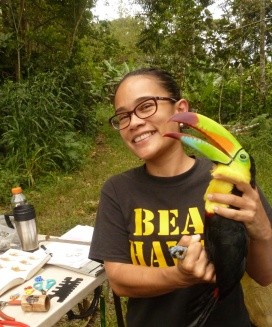 Keel-billed Toucan recently captured in one of our mist-netting stations. Photo Credit: Amilkar Moncada
Keel-billed Toucan recently captured in one of our mist-netting stations. Photo Credit: Amilkar Moncada
We focused on the contribution of birds to preying on a major coffee pest, the coffee boring beetle (Damon 2000, Vega et al. 2009). We did this by counting infected coffee berries on coffee plants that were surrounded by a netted enclosure to keep the birds out, to coffee plants that birds had access to.
While the study is still underway, our results show that coffee plants without bird exposure show a higher coffee berry borer infestation rate than those coffee plants where birds were present. Several new studies in Jamaica and Costa Rica show similar results (Kellermann et al. 2008, Johnson et al. 2008, Karp et al. 2013).
Likewise, CIRAD, CATIE and Bioversity researchers have found that at landscapes scales, fragmenting coffee landscapes with forest patches contributes to keeping the pest at bay (Avelino et al 2013). Birds, biodiversity and landscape arrangement alone are insufficient to control pest populations. Sound agricultural practices such as clean harvesting (removing all berries at harvest) are the number one factor in controlling this pest.
However, sound agricultural management, maintaining connectivity within farmscapes, and fragmenting continuous coffee parcels with forests all contribute to keeping the coffee borer pest below epidemic levels, reducing the need to apply noxious pesticides.
Bioversity, CIRAD, the University of Idaho, and CATIE continue to explore how managing biodiversity at multiple scales contributes to the management of multiple ecosystem services, including crop yield, pest control, pollination, and water quality, all while keeping a safe space for wild biodiversity. Do you have examples like this to share? Comment in the section below.
To learn more:
Bioversity International's 'Bridging Agriculture and Conservation Initiative'
About the authors:
Alejandra Martínez-Salinas is a Nicaraguan PhD student within the CATIE and University of Idaho Joint Doctoral Program working with Dr. Fabrice DeClerck from Bioversity, Dr. Kerri Vierling and Dr. Lee Vierling from the University of Idaho and Dr. Jacques Avelino from CIRAD. Alejandra is also associated to the GAMMA Program in CATIE.
Dr. Fabrice DeClerck lead’s WLE’s Ecosystem Services and Resilience Working Group.
Natalia Estrada-Carmona, is a PhD candidate within the CATIE and University of Idaho Joint Doctoral Program.
Dr. Kelly Garbach is associated to the Department of Environmental Science of the Loyola University in Chicago, IL, USA.
We thank financial support provided by the USFWS through their Wildlife Without Borders program (grants 98210-8-G709 and 96200-0-G068) and Neotropical Migratory Bird Conservation Act (grant F11AP01025). Financial support was also provided by the Wallace Genetic Foundation, CAFNET and PCP projects, CATIE, University of Idaho, and the CGIAR Research Program on Humid Tropics. Finally, we would like to thank the dozens of volunteers that through the years have helped us gathered information in our bird banding stations.
Citations:
Avelino, J; Romero-Gurdián, A; Cruz-Cuellar, H.F; DeClerck, FAJ. 2012. Landscape context and scale differentially impact coffee leaf rust, coffee Berry borer, and coffee root-knot nematodes. Ecological applications 22(2):584-596.
Damon, A. 2000. A review of the biology and control of the coffee berry borer, Hypothenemus hampei (Coleoptera: Scolytidae). Bulletin of Entomological Research. 90:453-465.
Johnson, MD; Kellermann, JL; Stercho, AM. 2010. Pest reduction services by birds in shade and sun coffee in Jamaica. Animal Conservation. Vol. 13:140-147.
Karp, DS; Mendenhall, CD; Figueroa Sandí, R; Chaumont, N; Ehrlich, PR; Hadly, EA; Daily, GC. 2013. Forest bolsters bird abundance, pest control and coffee yield. Ecology Letters, early view August 2013.
Kellermann JL; Johnson, MD; Stercho, AM; Hackett, SC. 2008. Ecological and economic services provided by birds on Jamaican blue mountain coffee farms. Conservation Biology. Vol. 22(5):1177-1185.
Vega, FE; Infante, F; Castillo, A; Jaramillo, J. 2009. The coffee berry borer, Hypothenemus hampei (Ferrari) (Coleoptera: Curculionidae): a short review, with recent findings and future research directions. Terrestrial Arthropod Reviews 2:129-147.
[1] CATIE is the Spanish acronym for the Tropical Agricultural Research and Higher Education Center, located in Turrialba, Costa Rica



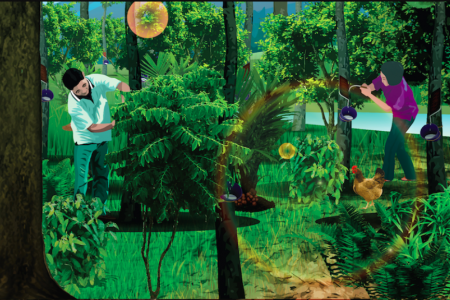








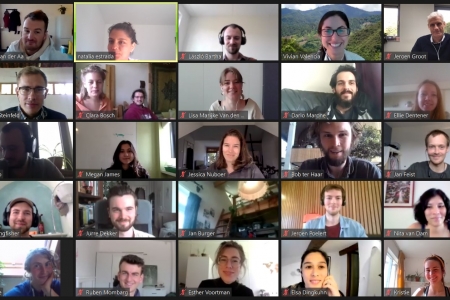



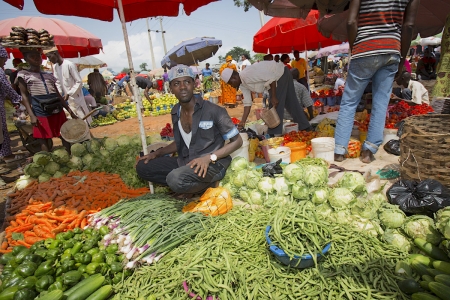


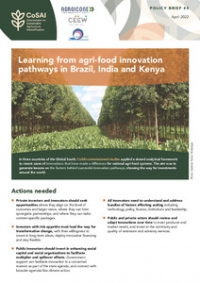
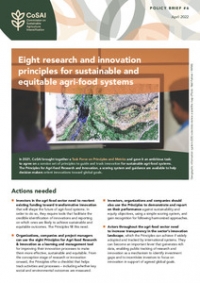
Add new comment